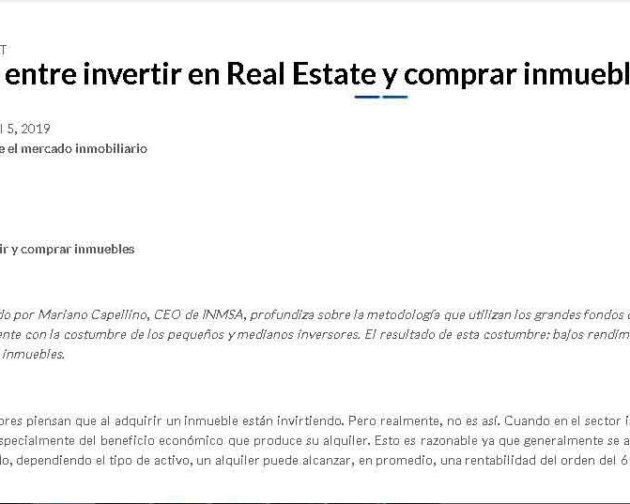The report developed by Mariano Capellino, CEO of INMSA, analyzes the methodology used by large investment funds when investing in real estate, which significantly differs from the traditional operations conducted by small and medium-size investors and which result in low returns and exposure to possible crises impacting on the value of their property.
In general, investors believe that they are making an investment by simply buying a property, but actually, it is not the case. When the real estate sector refers to property returns, it especially makes reference to the economic benefit obtained from its rental.
This is reasonable as property is usually acquired and kept for a long period of time. Today, at global level, depending on the type of asset involved, rental income can reach an annual 6% return on average, even though it may be lower in some countries.
But this return is a theoretical and gross amount, as it is not including a number of hidden costs which affect the final result, such as insurance, vacancy periods, administration costs, property taxes, maintenance costs and allowances for future repairing work, among others.
Finally, the return is almost half the number informed by the sector. When we speak about 6% return, actually the net amount received by the investor is approximately 3%.
In general, as the rental income is the only variable taken into account to define the property returns and, if a 3% rental is the percentage which can be obtained, it stands to reason that investing in real estate is not a very attractive and high-return operation.
In fact, the real estate investment is quite a different thing.
The real estate investments, as conducted by the largest investment funds, include 3 variables differentiating it from the traditional real estate sector which is oriented to the acquisition and maintenance of the property rather than to the real estate investments.
One of the key variables in a real estate investment is acquiring the asset at a price quite under the market value.
Real estate investment funds do not acquire assets at values set by real estate agents or developers to avoid the expenses involved in sale transactions and which accounting for about 10% (commissions and deeds), depending on the country involved.
If they did so, they would start losing 10% of their investment as it usually happens with real estate buyers. Professional players get important 20% – 30% discounts under the market value, therefore they start benefiting themselves from the beginning. They do so by acquiring real estate from banks which need to sell immediately or auctions.
The second key variable is the accelerated appreciation rate of the property.
In the long term, the actual appreciation rate of a property on a yearly basis, i.e. discounting inflation, is practically zero. This is why real estate assets are considered safe. Now, those investing professionally can achieve returns higher than 10% annually as they target markets which have gone through a deep crisis, with a strong correction of assets, causing property values to reach rock bottom and with evidence that their value is starting to recover their historic value.
In general, when a market drops 50% there is a margin between 80 and 100% increase which will take place in a period of 4-7 years, depending on the type and class of asset.
And the third variable is the maximization of the rental income. When a property is acquired at a value quite below its actual value, e.g. 50% under its historic price in developed markets where rentals remain steady, the rental income usually doubles in value.
In countries such as USA or Spain, for instance, rental values remain constant, i.e. as the real estate value has significantly dropped, its rental becomes really good business. For example, today Detroit provides a net rental income over 10% annually. In the suburbs of Madrid, the rental income has reached approximately 7% net amount yearly.
This picture shows the difference between the traditional real estate method and the professional approach. The latter being used by large investment funds or by a few real estate companies operating worldwide.
By being conservative, obtaining discounts on acquisition, rental income and appreciations, and implementing a professional approach, it is possible to obtain approximately 16.5% net rental income annually, without leverage, compared to an almost zero profitability provided by the traditional model.
That´s why we say that there is a big gap between acquiring a property to subsequently rent it and a true investment in real estate.
If you need advice on Real Estate Investments, contact us by clicking here
Source: https://icrowdnewswire.com/2019/07/05/el-abismo-entre-invertir-en-real-estate-y-comprar-inmuebles/

